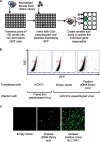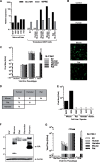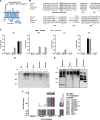Identification of the Receptor Used by the Ecotropic Mouse GLN Endogenous Retrovirus
- PMID: 30541852
- PMCID: PMC6384078
- DOI: 10.1128/JVI.01125-18
Identification of the Receptor Used by the Ecotropic Mouse GLN Endogenous Retrovirus
Abstract
Approximately 10% of the mouse genome is composed of endogenous retroviruses belonging to different families. In contrast to the situation in the human genome, several of these families correspond to recent, still-infectious elements capable of encoding complete viral particles. The mouse GLN endogenous retrovirus is one of these active families. We previously identified one fully functional provirus from the sequenced genome of the C57BL/6 mouse strain. The GLN envelope protein gives the infectious viral particles an ecotropic host range, and we had demonstrated that the receptor was neither CAT1 nor SMIT1, the two previously identified receptors for mouse ecotropic retroviral envelope proteins. In this study, we have identified SLC19A1, the reduced folate carrier, as the cellular protein used as a receptor by the GLN retrovirus. The ecotropic tropism exhibited by this envelope is due to the presence or absence of an N-linked glycosylation site in the first extracellular loop as well as the specific amino acid sequence of the extracellular domains of the receptor. Like all the other retroviral envelope proteins from the gammaretrovirus genus whose receptors have been identified, the GLN envelope protein uses a member of the solute carrier superfamily as a receptor.IMPORTANCE Endogenous retroviruses are genomic traces of past infections present in all vertebrates. Most of these elements degenerate over time and become nonfunctional, but the mouse genome still contains several families with full infection abilities. The GLN retrovirus is one of them, and its members encode particles that are able to infect only mouse cells. Here, we identified the cellular protein used as a receptor by GLN for cell entry. It is SLC19A1, the reduced folate carrier. We show that GLN infection is limited to mouse cells due to both a mutation in the mouse gene preventing the glycosylation of SLC19A1 and also other residues conserved within the rat but not in the hamster and human proteins. Like all other gammaretroviruses whose receptors have been identified, GLN uses a member of the solute carrier superfamily for cell entry, highlighting the role of these proteins for retroviral infection in mammals.
Keywords: ERV; Env; GLN; endogenous retrovirus; gammaretrovirus; receptor.
Copyright © 2019 American Society for Microbiology.
Figures





Similar articles
-
Reduced Folate Carrier: an Entry Receptor for a Novel Feline Leukemia Virus Variant.J Virol. 2019 Jun 14;93(13):e00269-19. doi: 10.1128/JVI.00269-19. Print 2019 Jul 1. J Virol. 2019. PMID: 30996094 Free PMC article.
-
Spontaneous heteromerization of gammaretrovirus envelope proteins: a possible novel mechanism of retrovirus restriction.J Virol. 2008 Oct;82(19):9789-94. doi: 10.1128/JVI.02696-07. Epub 2008 Jul 30. J Virol. 2008. PMID: 18667519 Free PMC article.
-
Recombinant Origins of Pathogenic and Nonpathogenic Mouse Gammaretroviruses with Polytropic Host Range.J Virol. 2017 Oct 13;91(21):e00855-17. doi: 10.1128/JVI.00855-17. Print 2017 Nov 1. J Virol. 2017. PMID: 28794032 Free PMC article.
-
Differential glycosylation of the Cas-Br-E env protein is associated with retrovirus-induced spongiform neurodegeneration.J Virol. 2000 Feb;74(3):1558-65. doi: 10.1128/jvi.74.3.1558-1565.2000. J Virol. 2000. PMID: 10627570 Free PMC article. Review.
-
From ancestral infectious retroviruses to bona fide cellular genes: role of the captured syncytins in placentation.Placenta. 2012 Sep;33(9):663-71. doi: 10.1016/j.placenta.2012.05.005. Epub 2012 Jun 12. Placenta. 2012. PMID: 22695103 Review.
Cited by
-
Koala retrovirus epidemiology, transmission mode, pathogenesis, and host immune response in koalas (Phascolarctos cinereus): a review.Arch Virol. 2020 Nov;165(11):2409-2417. doi: 10.1007/s00705-020-04770-9. Epub 2020 Aug 8. Arch Virol. 2020. PMID: 32770481 Free PMC article. Review.
-
The avian retroviral receptor Tva mediates the uptake of transcobalamin bound vitamin B12 (cobalamin).J Virol. 2021 Mar 25;95(8):e02136-20. doi: 10.1128/JVI.02136-20. Epub 2021 Jan 27. J Virol. 2021. PMID: 33504597 Free PMC article.
-
Cell-Int: a cell-cell interaction assay to identify native membrane protein interactions.Life Sci Alliance. 2024 Sep 5;7(11):e202402844. doi: 10.26508/lsa.202402844. Print 2024 Nov. Life Sci Alliance. 2024. PMID: 39237366 Free PMC article.
-
Mouse strain-specific polymorphic provirus functions as cis-regulatory element leading to epigenomic and transcriptomic variations.Nat Commun. 2021 Nov 9;12(1):6462. doi: 10.1038/s41467-021-26630-z. Nat Commun. 2021. PMID: 34753915 Free PMC article.
-
Reduced Folate Carrier: an Entry Receptor for a Novel Feline Leukemia Virus Variant.J Virol. 2019 Jun 14;93(13):e00269-19. doi: 10.1128/JVI.00269-19. Print 2019 Jul 1. J Virol. 2019. PMID: 30996094 Free PMC article.
References
Publication types
MeSH terms
Substances
LinkOut - more resources
Full Text Sources
Molecular Biology Databases
Miscellaneous

